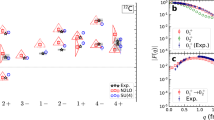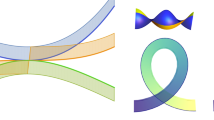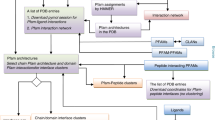Abstract
IT has been proposed that the insulin molecule has the C2 cage structure. This structure fits the chemical and physico-chemical facts and those relating to cell molecular weight, space group and cell dimensions1. The view that this structure is inconsistent with certain experimental vector diagrams constructed afterwards has been advanced. Thus Crowfoot, for reasons nowhere stated, writes: “from the cyclol structure one would expect many more peaks in the Patterson synthesis than do actually occur” 2. Alternatively, Bernal states that “the distribution of atoms in the cyclol skeleton is far too continuous to give rise to any definite peaks and no distribution of side chains can do other than increase the blurring of the picture”3. I can find no basis for either of these statements. The question of the vector map of the (C-C-N) units of the C2 skeleton (the main features of which are readily appreciated by looking at very simple diagrams of certain idealized structures already published4) has been specifically raised by Bernal3,5. This map has now been constructed by Riley and Fankuchen6, who use it to disprove two propositions, neither of which to my knowledge has been asserted, namely, (1) the insulin molecule consists of these 288 (C-C-N) units, and (2) these units and six points at the corners of a C2 skeleton have the same vector map. This map cannot be regarded as a contribution to the study of insulin, since chemical requirements alone dispose of any idea that the insulin molecule has the composition (C-C-N)288. However, the authors claim that it disproves also the hypothesis that insulin is a C2 structure consisting of 288 ((C(OH)CHR)-N) units. To reach this result, they contend, following Bernal3, that a decision regarding all C2 structures (which exceed 10400 in number) can be reached on the basis of a vector projection of their (C-C-N)units (which in the case of insulin represent 28 per cent by weight of the crystal) no matter what these 288 R groups may be, no matter how they may be arranged, no matter what may be the composition or arrangement of atoms in intermolecular spaces. This contention, in view of the fact that vector maps are not additive, can scarcely be correct. The issue raised, namely, my claim regarding the relation between the C2 structure and the particular vector projection of insulin which they discuss, remains unchanged. This claim runs “the 18 peaks per molecule are given in the correct positions, on the assumption that there are concentrations of atoms at the six slits”7.
This is a preview of subscription content, access via your institution
Access options
Subscribe to this journal
Receive 51 print issues and online access
$199.00 per year
only $3.90 per issue
Buy this article
- Purchase on Springer Link
- Instant access to full article PDF
Prices may be subject to local taxes which are calculated during checkout
Similar content being viewed by others
References
Wrinch, Science, 85, 568 (1937); Trans. Faraday Soc., 33, 1368 (1937).
Crowfoot, Proc. Roy. Soc., A, 164, 580 (1938).
Bernal, NATURE, 143, 75 (1939).
Phil. Mag., 27, 98 (Jan. 1939).
Physical Society, Dec. 20, 1938.
Riley and Fankuchen, NATURE, 143, 648 (1939).
Wrinch, J. Amer. Chem. Soc., 60, 2005 (1938).
Langmuir and Wrinch, Proc. Phys. Soc. (forthcoming).
Wrinch and Langmuir, J. Amer. Chem. Soc., 60, 2247 (1938).
Robertson, NATURE, 143, 74 (1939).
Proc. Roy. Soc. B, 127, 36 (1939).
Langmuir, Physical Society, Dec. 20, 1938 (in course of publication).
Wrinch, NATURE, 142, 956 (1938).
Robertson, Physical Society, Dec. 20, 1938.
Author information
Authors and Affiliations
Rights and permissions
About this article
Cite this article
WRINCH, D. The Cyclol Theory and the Structure of Insulin. Nature 143, 763–764 (1939). https://doi.org/10.1038/143763a0
Issue Date:
DOI: https://doi.org/10.1038/143763a0
This article is cited by
Comments
By submitting a comment you agree to abide by our Terms and Community Guidelines. If you find something abusive or that does not comply with our terms or guidelines please flag it as inappropriate.



